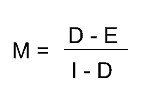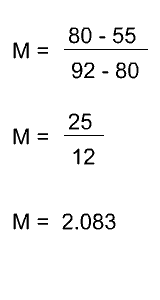Soil Amelioration (Amendment) Formula
Rootzones may wish to be ameliorated for several reasons.
For example, these may include
- increasing the sand content of a soil to assist in drainage potential,
- increasing the clay content of a soil on a cricket pitch that is to be reconstructed,
- mixing sand with a soil to make an appropriate top-dressing, etc.
To determine how much material, whether sand or clay, needs to be added and suitably mixed into an existing soil then a soil analysis needs to be carried out for both the existing soil and the imported material.
The same formula can be used for both requirements:

What does this mean?
- M = units (for example in tonnes) of imported Material (sand or clay) to add to one unit (one tonne) of the existing rootzone material;
- D = the Desired percentage of sand or clay in the finished rootzone;
- E = the Existing percentage of sand or clay in the current rootzone;
- I = the percentage of sand or clay in the Imported material.
Once the calculation has been determined, it may be found for example, that to ameliorate the existing rootzone to the desired sand or clay content then 4 tonnes of the imported sand/clay needs to be added to 1 tonne of the existing rootzone.
Completed Example : Sand Amelioration
A sports area is to be ameliorated to increase the sand content in the rootzone to 80 percent.
How much sand, of the desirable particle size range, needs to be added for each unit of existing rootzone?
In this example we will say that the desirable particle size range is 0.125 - 0.500 mm.
The required figures (for this exercise) are as follows:
- D = 80%;
- E = 55%;
- I = 92%

In this example there is a need to provide 2.083 tonnes of sand to each tonne of existing rootzone (i.e. soil). This sand would need to be incorporated into the existing soil either by
- mixing by shovel, tractor bucket, shredder etc. if mixing a top-dressing or excavated soil that is ameliorated and then returned to a pitch, or
- through rotovating, power harrowing or other appropriate means to ensure an even mixing is carried out when the sand is mixed into the existing soil. This second operation can be difficult to achieve in practice.
To work out your own examples, use our specialist calculator for determining how much material is needed for amelioration purposes.
The next part of this article will look at how much material will be required for a particular facility.
How Much Sand will be required for a Mini-Football Pitch?
If we estimate that a mini-football pitch is 30m x 40m (1,200m²) in size and the new depth of the ameliorated rootzone is to be 100mm, then the following calculations will provide a reasonable estimate of the total sand required to mix with the existing soil.
First we need to calculate how much sand needs to be mixed with each cm of existing soil:
Take the calculated M figure above = 2.083 and divide this by the bulk density of the sand, e.g. 1.5 t/m³ = 1.389 cm of sand to be mixed with one cm of existing cultivated soil*.
*The existing soil will have to be rotovated, or similar, to break up surface compaction before mixing with sand. It is the depth of the cultivated soil that is required as this will typically be in the region of 1 t/m³ which is what the calculation is based on.
One unit of finished mix will be 1 cm cultivated soil with 1.389 cm of sand = 2.389cm.
Therefore to determine the total proportions of both sand and soil we divide the required mixed depth, i.e. 10cm by the unit mixed depth of 2.389cm = 4.186 units. The sand component is 5.814 and the soil is 4.186. In practical terms this means mixing 6 cm of sand with 4 cm of cultivated soil.
